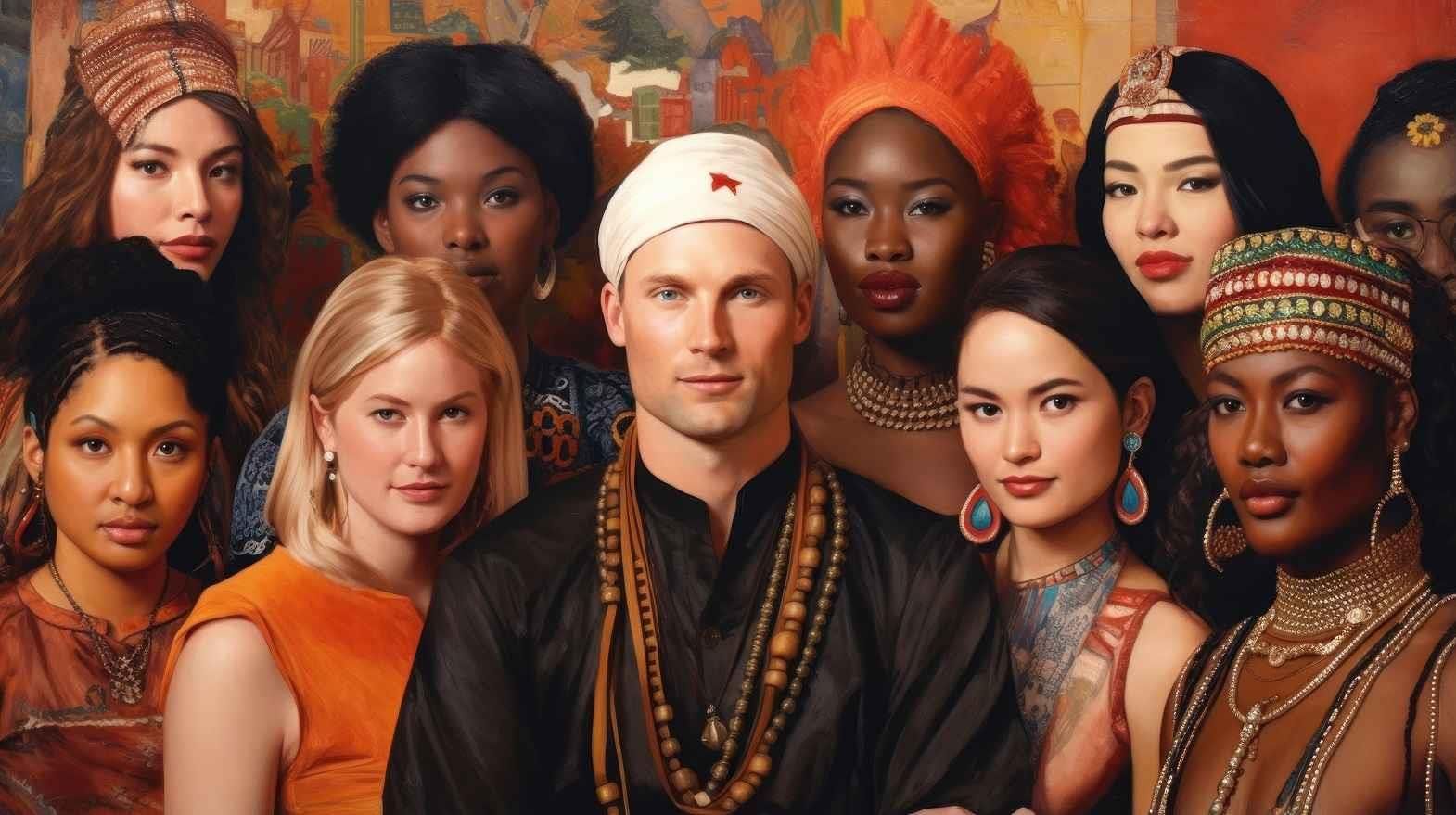Fashion is often perceived as an industry that encompasses the creative expression of designers, brands, and fashion firms, generating significant economic impact globally. For example, the fashion sector in France is heavily subsidised and regulated by the government due to its considerable social and economic influence.
Cultural Appropriation and the Need for Vigilance in the Fashion Industry
In today’s era, fashion designers and companies must be vigilant when drawing inspiration from indigenous cultures, as awareness of cultural appropriation has increased. The fashion industry could benefit from adopting sustainable production methods and principles of ethnic groups. This approach could potentially lead to more equitable and sustainable practices than those currently associated with the fashion industry. However, the scalability of such a model remains a question.
Cultural Sustainability in Fashion
Cultural sustainability is based on the principle that the current generation should only use and adapt cultural heritage to the extent that allows future generations to understand and preserve the rich diversity of meanings and values embedded in it. Weaving has been integral in shaping cultural identities and is a part of cultural heritage. The traditional attire of various ethnic groups and indigenous people worldwide exemplify this.
Fashion’s Influence Beyond Clothing
Fashion’s influence extends beyond clothing to include hairstyling, makeup, and accessories. For instance, traditional African hairstyles like locs and braids have been popularised globally by numerous celebrities and influencers. Similarly, traditional Indian accessories like bindis, henna tattoos, and turbans have gained international popularity, often shedding their ethnic significance.
Cultural Sustainability in Textiles
In the context of fashion and textiles, cultural sustainability involves passing down traditional textile knowledge and manifestations of textile culture to future generations. This is vital in maintaining the integrity and diversity of global cultural heritage in the fashion industry.
The Values of Cultures in Fashion Production
Ethnic cultures provide valuable insights into clothing production practices that go beyond mere weaving skills and patterns. Historically, these communities have co-existed harmoniously with Mother Earth, preserving their techniques, culture, stories, and designs. The fashion industry is now gradually moving towards honouring these communities and promoting local sustainability, aiming to shed its purely corporate nature.
Sustainable Principles Rooted in Indigenous Values
A core principle common in many ethnic cultures is to never take more than necessary. This belief is grounded in the understanding that overconsumption can disrupt natural balance, leading to catastrophic consequences for both the community and the environment. This principle forms the foundation of a business concept rooted in indigenous values, emphasising sustainability and respect for nature.
Learning from Ethnic Communities in the Western World
In the fast-paced, technologically-driven Western world, the harmony with the environment, seasons, and nature is often lost. Learning from ethnic communities becomes crucial to regaining this balance. The fashion industry, often oblivious to its impacts, can significantly benefit from the principles of slow fashion advocated by indigenous cultures. This approach influences not just aesthetics and techniques but also prompts a re-evaluation of people’s ethical framework and how they coexist with nature.
The Future of Fashion Brands in a Competitive Environment
The question remains whether fashion brands can thrive in a competitive environment while adopting these sustainable and ethical principles. By integrating the values of harmony, sustainability, and respect for nature, fashion brands can not only survive but also lead the way in a new era of responsible and conscious fashion.
The Cultural Context of Fashion and Style
Fashion and style are products of the culture in which they are produced, reflecting local customs and cultural history. Traditional clothes and dress serve as a mirror to a society’s cultural heritage, influencing the use of materials and textiles in fashion. Fashion is not only a means of personal expression but is also shaped by the cultural environments in which it is practiced. It is both a reflection of and a response to the cultural influences that define our world, from the vivid colours of traditional clothes to the clean lines of contemporary designs.
Importance of Traditional Garments and Attire in the Current Fashion Scenario
In the current fashion landscape, traditional clothing and attire hold a significant place, showcasing the deep impact of culture on fashion. Civilisations across the globe boast unique fashion traditions that are deeply embedded in their history and ancestry. For instance, the vibrant and intricate sarees of India celebrate the nation’s diverse regional customs and rich cultural heritage, while the kimono, a traditional Japanese garment, represents modesty, reverence, and elegance.
These traditional garments, with their distinct designs, colours, and styles, have been passed down through generations, helping to preserve cultural legacies. Consider the durag in the African American community, which has transcended its practical use for hair protection to become a symbol of shared cultural experience. However, when culturally significant items like the durag are adopted by public figures from different cultural backgrounds, such as Kylie Jenner, it can lead to controversy. This is because these items are not just material objects; they represent the struggles, triumphs, and lived experiences of a specific culture. People’s clothing tells stories about their heritage and culture; these are not mere fashion statements to be casually adopted or discarded.
Therefore, it is crucial for fashion brands to approach the cultural significance of the garments they sell and promote with mindfulness and respect.
How Culture Influences Materials and Textiles in Fashion
Culture also plays a significant role in shaping the choice of fabrics and textiles in fashion, as design is often influenced by the materials available to different regions and cultures. For example, China’s long history in silk production has made silk a central element in Chinese fashion. Similarly, African textiles are renowned for their intricate patterns and vibrant Ankara prints, reflecting the continent's rich cultural heritage and skilled craftsmanship.
The selection of materials is a crucial aspect of how culture impacts fashion design. Designers frequently incorporate materials from various cultures, each with its own unique traditions and techniques, to create distinctive designs. Indian lifestyle accessories, for instance, often feature traditional textiles like cotton and silk. African prints, celebrated for their vivid colours and patterns, are also popular in clothing and accessory design, both within Africa and internationally.
In India, the handloom sector is not only a major contributor to exports but also provides livelihoods for many underprivileged communities. Thus, the Indian handloom textiles represent more than just fabric; they are an integral part of the country’s rich cultural legacy, interweaving history, tradition, and artistry.
Influence of Cultural Trends on Social and Political Movements
Fashion extends beyond traditional clothing and materials to influence broader social and political movements. Throughout history, many activist groups have used fashion as a strategic tool, leveraging the intersection of fashion, feminism, and politics. The combination of fashion and activism has often driven social and political changes, with certain garments providing a visual identity to historical and contemporary social movements.
Fashion has also served as a medium for expressing identity and staging protests. For instance, during the American Civil Rights Movement, African Americans utilised fashion to challenge social norms and assert cultural pride. Garments like the Dashiki and the Afro hairstyle became symbols of black power and resistance, representing a stand against racial injustice and a celebration of African heritage. This exemplifies the profound impact fashion can have as a tool for advocacy and change.
Cultural Appropriation in Fashion
The fashion industry has long faced the issue of cultural appropriation, a significant problem that has gained prominence in recent years. Cultural appropriation involves adopting elements of another culture without understanding or respecting their significance, leading to the commercialisation and distortion of cultural symbols. This often reinforces stereotypes and obscures the true cultural context.
While collaboration is a valued aspect of the creative fashion world, it must be approached with sensitivity and respect. Cultural appropriation in fashion is often seen as a misrepresentation of the cultures involved, and it is concerning when companies and designers adopt elements from minority cultures without awareness of the challenges and struggles faced by these groups.
There is also confusion regarding who is entitled to wear what, especially with the availability of authentic creations by artists from the cultures where these designs originate. Both consumers and fashion designers must be aware of the cultural origins of the designs they embrace and ensure they offer appropriate recognition and respect. This awareness is crucial in maintaining the integrity and significance of cultural expressions within the fashion industry.
Conclusion: Respecting Cultural Influences in Fashion and Style
Cultural influences are deeply intertwined with fashion and style, shaping people’s choices and impacting everything from traditional clothing and materials to broader social and political movements. To celebrate diversity and avoid cultural appropriation, it is essential to approach cultural influences with respect and understanding. This approach allows people to honour the myriad cultures that enrich the fashion and style industry.
In summary, culture significantly influences the design of lifestyle accessories. Designers should consider cultural significance in every aspect of their work, from materials and colours to patterns, values, and symbols. By doing so, they can create accessories that are functional, stylish, and respect cultural identity. Furthermore, cultural references in design can appeal to a broader audience, promoting equality and diversity in the fashion industry.
Moreover, cultures have a profound yet straightforward impact on slow fashion. Stripping away the buzzwords from various contemporary sustainability initiatives, such as farm-to-closet, regenerative fashion, or fashion-on-demand, reveals that they often reflect the traditional practices of indigenous peoples and ancient societies. Consumers, therefore, have a responsibility to reassess their values, live harmoniously with the environment, purchase sustainable products. This conscious approach is essential for a more equitable and sustainable future in fashion.











Comments